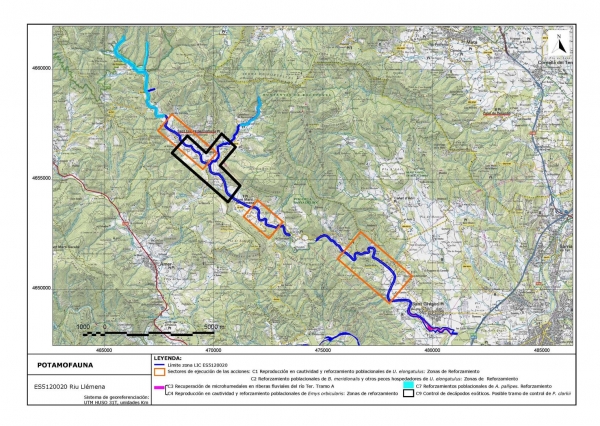Llémena River
Surface: 194.000 ha.
The Natura 2000 Llémena River (ES5120020) is a river area with riparian forests in good condition and has an important role as a biological corridor. The stream is a tributary of Ter along its left bank, oriented northwest to southeast. The basin extends from the towns of Sant Aniol the Finestres, Sant Martí Llémena, Canet d'Adri and Sant Gregori; is limited in its north-eastern side of the Serra de Finestres, and the Rocacorba Massif and the south-west by the Serra de Medes, the cliffs of San Roc and Mountain of Sant Grau. This watercourse is conditioned from birth to mineral water bottling water Sant Aniol, extracting an unknown part of the flow. However this stream has a remarkable quality and the water can be found amphibians, mollusks or invertebrates and other quality indicators. On the bed there are alder and other species of trees and plants that also denote the quality of resources. In addition there are species of birds like Kingfisher or Yellow Wagtail.
The importance of the river Llémena populations of target species of this project -essentially Unio elongatulus, Barbus meridionalis and Astropotamobius pallipes-, is remarkable, although difficult to quantify in terms of demography.
The Naiad Unio elongatulus. Its regression in Catalan Basins has been dramatic. The population of this species existing in the Llémena River is one of the few well preserved ones, added to the one of Brugent River, and in the whole basin of northeastern Catalonia. In the Llémena River there is a single population of Unio elongatulus, located in a section with a shape similar to a water channel with slow and uniform course. Within the river basin of the River Ter, this is one of the populations situated further upstream, and better condition, although there is insufficient data.
Some actions are planned such as stocking with captive-bred breeding laboratory naiads in Consorci de l’Estany from parental individuals of the same river basin. Since there may be some genetic differentiation between basins and sub-basins, the units used must come from production lines based on the same parental space or spaces next within the same watershed (Llémena River or in Brugent River). In each of these areas between 2 and 4 sectors will be chosen, where reinforcements will be conducted with youth naiads and infestations of wild fish with naiads. These sectors will be allocated based on information previously available on the general state of the rivers in the area of general scope of the project and the current understanding of the requirements of the species and the status of their populations. Chosen stretches of river with a stable river channel morphology, suitable courses, good water quality, scarce natural hydrological stress, general good ecological status and the presence of at least one species of native fish host, among other criteria. Noted that in the area have not yet been identified as species Dreissena polymorpha and Corbicula fluminea, but it has been found Anodonta woodiana an invasive bivalve. The threat of these species in the wetlands of Catalonia is very high, even in stagnant water bodies such as lakes and marshes.
Mediterranean Barbel (Barbus meridionalis). This species is experiencing a gradual decline in the whole small distribution area, located in southern Europe. While still maintaining stable populations in dense areas or in some rivers, it has disappeared from many sectors, especially along the main river zones where has previously occupied. In the basin of Llémena River, Barbus meridionalis still holds stable populations, but is generally in decline, having disappeared completely from the middle-bottom of the river. The recovery actions for Barbus meridionalis in Llémena River depend on the relationship with stock recovery Unio elongatulus. In places where it is intended to repopulate youth Unio elongatulus bred in captivity, studied the composition of fish, to ensure the presence of the guests for naiads such as Barbus meridionalis, Squalius laietanus or Salaria fluviatilis. In case of not having the presence of these species, reforestation run occasionally with Barbus meridionalis.
White-clawed Crayfish (Austropotamobius pallipes). Catalogue of threatened fauna of Catalonia (pending approval) species considered endangered (its short-term survival is unlikely). Wide distribution in Catalonia, but very localized mainly in small creeks and streams undisturbed.
The situation of the crayfish is delicate in Llémena river, although it keeps at least six places where with small populations, scattered in small streams and rivers in the main channel of the upper course of the river. The populations are located where the fungus plague could not get the Crayfish. Currently populations suffer the threat of the spread of invasive crayfish.
This space also has joined the project to conserve populations of White-clawed Crayfish (Austropotamobius pallipes). The precise details about the process of reproduction in captivity of Austropotamobius pallipes are found in the corresponding protocol established in accordance with the objectives of the project. One of the special conditions to be included in this protocol is the maintenance of breeding lines for each separate area of origin of the parental units. The reinforcements population will be carried out in appropriate sectors of the SCI included in the performance area of the project. In the sectors where the species has disappeared, but always within SCI where still present, this will enable the establishment of new populations are at least 1 in every SCI.

















